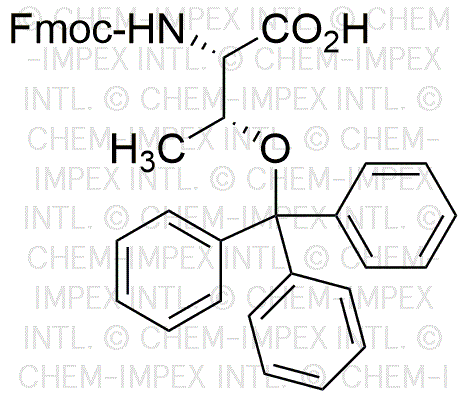Fmoc-O-trityl-L-threonine is widely utilized in research focused on:
- Peptide Synthesis: This compound serves as a protecting group in the synthesis of peptides, allowing for selective reactions without interfering with other functional groups. Its stability under various conditions makes it a preferred choice for chemists.
- Drug Development: In pharmaceutical research, it plays a crucial role in the design of peptide-based drugs, enhancing bioavailability and stability, which are critical for therapeutic efficacy.
- Biotechnology: Used in the production of recombinant proteins, it aids in the development of biopharmaceuticals, ensuring that proteins maintain their functional integrity during synthesis.
- Analytical Chemistry: This compound is valuable in the development of analytical methods for characterizing peptides, providing researchers with reliable data for quality control and formulation studies.
- Academic Research: It is frequently employed in educational settings for teaching organic synthesis techniques, helping students understand the intricacies of chemical reactions and molecular manipulation.
General Information
Properties
Safety and Regulations
Applications
Fmoc-O-trityl-L-threonine is widely utilized in research focused on:
- Peptide Synthesis: This compound serves as a protecting group in the synthesis of peptides, allowing for selective reactions without interfering with other functional groups. Its stability under various conditions makes it a preferred choice for chemists.
- Drug Development: In pharmaceutical research, it plays a crucial role in the design of peptide-based drugs, enhancing bioavailability and stability, which are critical for therapeutic efficacy.
- Biotechnology: Used in the production of recombinant proteins, it aids in the development of biopharmaceuticals, ensuring that proteins maintain their functional integrity during synthesis.
- Analytical Chemistry: This compound is valuable in the development of analytical methods for characterizing peptides, providing researchers with reliable data for quality control and formulation studies.
- Academic Research: It is frequently employed in educational settings for teaching organic synthesis techniques, helping students understand the intricacies of chemical reactions and molecular manipulation.
Documents
Safety Data Sheets (SDS)
The SDS provides comprehensive safety information on handling, storage, and disposal of the product.
Product Specification (PS)
The PS provides a comprehensive breakdown of the product’s properties, including chemical composition, physical state, purity, and storage requirements. It also details acceptable quality ranges and the product's intended applications.
Certificates of Analysis (COA)
Search for Certificates of Analysis (COA) by entering the products Lot Number. Lot and Batch Numbers can be found on a product’s label following the words ‘Lot’ or ‘Batch’.
Numéro de catalogue
Numéro de lot/série
Certificates Of Origin (COO)
This COO confirms the country where the product was manufactured, and also details the materials and components used in it and whether it is derived from natural, synthetic, or other specific sources. This certificate may be required for customs, trade, and regulatory compliance.
Numéro de catalogue
Numéro de lot/série
Safety Data Sheets (SDS)
The SDS provides comprehensive safety information on handling, storage, and disposal of the product.
DownloadProduct Specification (PS)
The PS provides a comprehensive breakdown of the product’s properties, including chemical composition, physical state, purity, and storage requirements. It also details acceptable quality ranges and the product's intended applications.
DownloadCertificates of Analysis (COA)
Search for Certificates of Analysis (COA) by entering the products Lot Number. Lot and Batch Numbers can be found on a product’s label following the words ‘Lot’ or ‘Batch’.
Numéro de catalogue
Numéro de lot/série
Certificates Of Origin (COO)
This COO confirms the country where the product was manufactured, and also details the materials and components used in it and whether it is derived from natural, synthetic, or other specific sources. This certificate may be required for customs, trade, and regulatory compliance.


